Multivariate Attention-Based Orbit Uncertainty Propagation and Orbit Determination Method for Earth–Jupiter Transfer
Abstract
1. Introduction
- A multivariate attention-based neural network (MANN), rather than a simple DNN, is designed and utilized to replace the orbit integration process in the UT and UKF. It will be shown that the designed MANN has a much more advanced performance than the DNN in the investigated problem.
- An Earth–Jupiter transfer case, rather than an LEO case, is considered in this work. The input structure of the sample is comprehensively discussed and carefully designed.
- A method for fast generating a large number of samples for the Earth–Jupiter transfer case is presented.
2. Neural Network-Based Orbit Uncertainty Propagation Orbit Determination Framework
2.1. Orbit Uncertainty Propagation
2.2. Orbit Determination Method
- A.
- Time Update
- Given the estimated state and the associated covariance at epoch , calculate the predicted state and the associated covariance :
- B.
- Measurement update
- Calculate the Cholesky decomposition of and generate sigma points .
- Calculate the predicted measurement and the associated covariance and :
- When the measurement has been collected, calculate the estimated state and the associated covariance at epoch :
3. Construction and Training of the Multivariate Attention Neural Network
3.1. Sample Construction
- The initial state of the nominal orbit: .
- The initial deviation: .
- The orbital state of the nominal orbit at the epoch t: .
- The orbit deviation propagated using the two-body dynamics: .
- The deviation between the nominal orbits propagated using the high-fidelity and two-body dynamics: . This variable is expected to carry the information on the errors between the high-fidelity and two-body dynamics.
- The state vectors of the Earth, Mars, and Jupiter in the heliocentric inertial coordinate at the initial epoch : , , and . These variables contain information about the gravitational perturbation of the third body. Here, both the position of the perturbed object and the velocity of the perturbed bodies are considered, as the positions of the perturbed bodies in have an effect on the orbital propagation and adding the velocities of the perturbed bodies to the sample helps to provide information about the position of the perturbed bodies at future times.
- The propagated interval: . This is an important variable, as a longer propagated interval usually indicates more significant orbital deviations.
- The variable related to the SRP: .
3.2. Structure of the Neural Network
3.3. Training of the Neural Network
4. Simulation Results
5. Conclusions
Author Contributions
Funding
Institutional Review Board Statement
Informed Consent Statement
Data Availability Statement
Conflicts of Interest
References
- Bechini, M.; Gu, G.; Lunghi, P.; Lavagna, M. Robust spacecraft relative pose estimation via CNN-aided line segments detection in monocular images. Acta Astronaut. 2024, 215, 20–43. [Google Scholar] [CrossRef]
- Zhou, X.; Wang, S.; Qin, T. Multi-Spacecraft Tracking and Data Association Based on Uncertainty Propagation. Appl. Sci. 2022, 12, 7660–7671. [Google Scholar] [CrossRef]
- Christian, J.A. Optical Navigation Using Iterative Horizon Reprojection. J. Guid. Control Dyn. 2016, 39, 1092–1103. [Google Scholar] [CrossRef]
- Zhao, Y.; Yang, H.; Li, S.; Zhou, Y. On-board modeling of gravity fields of elongated asteroids using Hopfield neural networks. Astrodynamics 2023, 7, 101–114. [Google Scholar] [CrossRef]
- Qiao, D.; Zhou, X.; Zhao, Z.; Qin, T. Asteroid Approaching Orbit Optimization Considering Optical Navigation Observability. IEEE Trans. Aerosp. Electron. Syst. 2022, 58, 5165–5179. [Google Scholar] [CrossRef]
- Ogawa, N.; Terui, F.; Mimasu, Y.; Yoshikawa, K.; Ono, G.; Yasuda, S.; Matsushima, K.; Masuda, T.; Hihara, H.; Sano, J.; et al. Image-based autonomous navigation of Hayabusa2 using artificial landmarks: The design and brief in-flight results of the first landing on asteroid Ryugu. Astrodynamics 2020, 4, 89–103. [Google Scholar] [CrossRef]
- Qi, Y.; De Ruiter, A. Study of correction maneuver for lunar flyby transfers in the real ephemeris. J. Guid. Control Dyn. 2018, 41, 2112–2132. [Google Scholar] [CrossRef]
- Zhou, X.; Li, X.; Huo, Z.; Meng, L.; Huang, J. Near-Earth Asteroid Surveillance Constellation in the Sun-Venus Three-Body System. Space Sci. Technol. 2022, 2022, 9864937. [Google Scholar] [CrossRef]
- Christian, J.A. Pole Estimation and Optical Navigation Using Circle of Latitude Projections. J. Guid. Control Dyn. 2023, 47, 407–416. [Google Scholar] [CrossRef]
- Ma, X.; Fang, J.; Ning, X. An overview of the autonomous navigation for a gravity-assist interplanetary spacecraft. Prog. Aerosp. Sci. 2013, 63, 56–66. [Google Scholar] [CrossRef]
- Andreis, E.; Franzese, V.; Topputo, F. Onboard Orbit Determination for Deep-Space CubeSats. J. Guid. Control Dyn. 2022, 45, 1466–1480. [Google Scholar] [CrossRef]
- Zhou, X.; Qin, T.; Meng, L. Maneuvering Spacecraft Orbit Determination Using Polynomial Representation. Aerospace 2022, 9, 257. [Google Scholar] [CrossRef]
- Bețco, D.; Pârvu, P.V.; Ciudin, S. Autonomous navigation for the Martian Inspection Drone. Acta Astronaut. 2024, 216, 55–63. [Google Scholar] [CrossRef]
- Fossà, A.; Losacco, M.; Armellin, R. Perturbed initial orbit determination. Astrodynamics 2024, 1–6. [Google Scholar] [CrossRef]
- Yin, W.; Shi, Y.; Shu, L.; Gao, Y. Autonomous navigation of an asteroid orbiter enhanced by a beacon satellite in a high-altitude orbit. Astrodynamics 2024. [Google Scholar] [CrossRef]
- Capuano, V.; Harvard, A.; Chung, S.J. On-board cooperative spacecraft relative navigation fusing GNSS with vision. Prog. Aerosp. Sci. 2022, 128, 100761. [Google Scholar] [CrossRef]
- Peng, H.; Bai, X. Comparative evaluation of three machine learning algorithms on improving orbit prediction accuracy. Astrodynamics 2019, 3, 325–343. [Google Scholar] [CrossRef]
- Sun, Q.; Gutiérrez, J.L.R.; Yu, X. Deep Neural Network-Based 4-Quadrant Analog Sun Sensor Calibration. Space Sci. Technol. 2023, 3, 24. [Google Scholar] [CrossRef]
- Izzo, D.; Märtens, M.; Pan, B. A survey on artificial intelligence trends in spacecraft guidance dynamics and control. Astrodynamics 2019, 3, 287–299. [Google Scholar] [CrossRef]
- Yu, Z.; Cui, P.; Crassidis, J.L. Design and optimization of navigation and guidance techniques for Mars pinpoint landing: Review and prospect. Prog. Aerosp. Sci. 2017, 94, 82–94. [Google Scholar] [CrossRef]
- Ge, D.; Cui, P.; Zhu, S. Recent development of autonomous GNC technologies for small celestial body descent and landing. Prog. Aerosp. Sci. 2019, 110, 100551. [Google Scholar] [CrossRef]
- Li, R.; Sun, C.; Yu, X.; Zhang, L.; Wei, J.; Fang, Q. Space Noncooperative Target Trajectory Tracking Based on Maneuvering Parameter Estimation. Space Sci. Technol. 2024, 3, 78. [Google Scholar] [CrossRef]
- Luo, Y.; Yang, Z. A review of uncertainty propagation in orbital mechanics. Prog. Aerosp. Sci. 2017, 89, 23–39. [Google Scholar] [CrossRef]
- Garcia, R.V.; Pardal, P.; Kuga, H.K.; Zanardi, M.C. Nonlinear filtering for sequential spacecraft attitude estimation with real data: Cubature Kalman Filter, Unscented Kalman Filter and Extended Kalman Filter. Adv. Space Res. 2019, 63, 1038–1050. [Google Scholar] [CrossRef]
- Yan, H.; Liu, H.; Sun, X.; Xu, M. Accuracy Evaluation of Marginalized Unscented Kalman Filter. Space Sci. Technol. 2024, 3, 85. [Google Scholar] [CrossRef]
- Zhou, X.; Jia, F.; Li, X. Configuration Stability Analysis for Geocentric Space Gravitational-Wave Observatories. Aerospace 2022, 9, 519. [Google Scholar] [CrossRef]
- Santos-León, J.C.; Orive, R.; Acosta, D.; Acosta, L. The Cubature Kalman Filter revisited. Automatica 2021, 127, 109541. [Google Scholar] [CrossRef]
- Qiao, D.; Zhou, X.; Li, X. Analytical configuration uncertainty propagation of geocentric interferometric detection constellation. Astrodynamics 2023, 7, 271–284. [Google Scholar] [CrossRef]
- Zhou, X.; Cheng, Y.; Qiao, D.; Huo, Z. An adaptive surrogate model-based fast planning for swarm safe migration along halo orbit. Acta Astronaut. 2022, 194, 309–322. [Google Scholar] [CrossRef]
- Roa, J.; Park, R.S. Reduced Nonlinear Model for Orbit Uncertainty Propagation and Estimation. J. Guid. Control Dyn. 2021, 44, 1578–1592. [Google Scholar] [CrossRef]
- Qiao, D.; Zhou, X.; Li, X. Feasible domain analysis of heliocentric gravitational-wave detection configuration using semi-analytical uncertainty propagation. Adv. Space Res. 2023, 72, 4115–4131. [Google Scholar] [CrossRef]
- Park, R.S.; Scheeres, D.J. Nonlinear mapping of Gaussian statistics: Theory and applications to spacecraft trajectory design. J. Guid. Control Dyn. 2006, 29, 1367–1375. [Google Scholar] [CrossRef]
- Park, R.S.; Scheeres, D.J. Nonlinear semi-analytic methods for trajectory estimation. J. Guid. Control Dyn. 2007, 30, 1668–1676. [Google Scholar] [CrossRef]
- Sun, P.; Colombo, C.; Trisolini, M.; Li, S. Hybrid Gaussian Mixture Splitting Techniques for Uncertainty Propagation in Nonlinear Dynamics. J. Guid. Control Dyn. 2022, 46, 770–780. [Google Scholar] [CrossRef]
- Kim, Y.; Park, S.Y. Perturbative analysis on orbital kinematics of flybys and applications to Doppler observation. J. Guid. Control Dyn. 2015, 38, 1690–1698. [Google Scholar] [CrossRef]
- Boone, S.; McMahon, J. Directional State Transition Tensors for Capturing Dominant Nonlinear Effects in Orbital Dynamics. J. Guid. Control Dyn. 2022, 46, 431–442. [Google Scholar] [CrossRef]
- Hu, R.; Huang, X.; Xu, C. Integrated visual navigation based on angles-only measurements for asteroid final landing phase. Astrodynamics 2023, 7, 69–82. [Google Scholar] [CrossRef]
- Mortari, D.; Conway, D. Single-point position estimation in interplanetary trajectories using star trackers. Celest. Mech. Dyn. Astron. 2017, 128, 115–130. [Google Scholar] [CrossRef]
- Christian, J.A. Optical Navigation Using Planet’s Centroid and Apparent Diameter in Image. J. Guid. Control Dyn. 2014, 38, 192–204. [Google Scholar] [CrossRef]
- Ely, T.; Bhaskaran, S.; Bradley, N.; Lazio, T.J.W.; Martin-Mur, T. Comparison of Deep Space Navigation Using Optical Imaging, Pulsar Time-of-Arrival Tracking, and/or Radiometric Tracking. J. Astronaut. Sci. 2022, 69, 385–472. [Google Scholar] [CrossRef]
- Wang, Y.; Bai, X.; Peng, H.; Chen, G.; Shen, D.; Blasch, E.; Sheaff, C.B. Gaussian-Binary classification for resident space object maneuver detection. Acta Astronaut. 2021, 187, 438–446. [Google Scholar] [CrossRef]
- Zhou, X.; Qin, T.; Macdonald, M.; Qiao, D. Observability analysis of cooperative orbit determination using inertial inter-spacecraft angle measurements. Acta Astronaut. 2023, 210, 289–302. [Google Scholar] [CrossRef]
- Prabhu, K.; Majji, M.; Alfriend, K.T. Least Sum of Absolute Residuals Orbit Determination. J. Guid. Control Dyn. 2021, 45, 468–480. [Google Scholar] [CrossRef]
- Schiemenz, F.; Utzmann, J.; Kayal, H. Adaptive Gaussian Mixture based orbit determination with combined atmospheric density uncertainty consideration. Adv. Space Res. 2020, 66, 1609–1634. [Google Scholar] [CrossRef]
- Zhou, X.; Qiao, D.; Li, X. Adaptive Order-Switching Kalman Filter for Orbit Determination Using Deep-Neural-Network-Based Nonlinearity Detection. J. Spacecr. Rocket. 2023, 60, 1724–1741. [Google Scholar] [CrossRef]
- Zhou, X.; Qiao, D.; Li, X. Neural Network-Based Method for Orbit Uncertainty Propagation and Estimation. IEEE Trans. Aerosp. Electron. Syst. 2024, 60, 1176–1193. [Google Scholar] [CrossRef]
- Greco, C.; Vasile, M. Robust Bayesian Particle Filter for Space Object Tracking Under Severe Uncertainty. J. Guid. Control Dyn. 2021, 45, 481–498. [Google Scholar] [CrossRef]
- Khatri, Y.; Scheeres, D.J. Nonlinear semi-analytical uncertainty propagation for conjunction analysis. Acta Astronaut. 2023, 203, 568–576. [Google Scholar] [CrossRef]
- Casini, S.; Cervone, A.; Monna, B.; Gill, E. On line-of-sight navigation for deep-space applications: A performance analysis. Adv. Space Res. 2023, 72, 2994–3008. [Google Scholar] [CrossRef]
- Hu, Y.; Sharf, I.; Chen, L. Three-spacecraft autonomous orbit determination and observability analysis with inertial angles-only measurements. Acta Astronaut. 2020, 170, 106–121. [Google Scholar] [CrossRef]

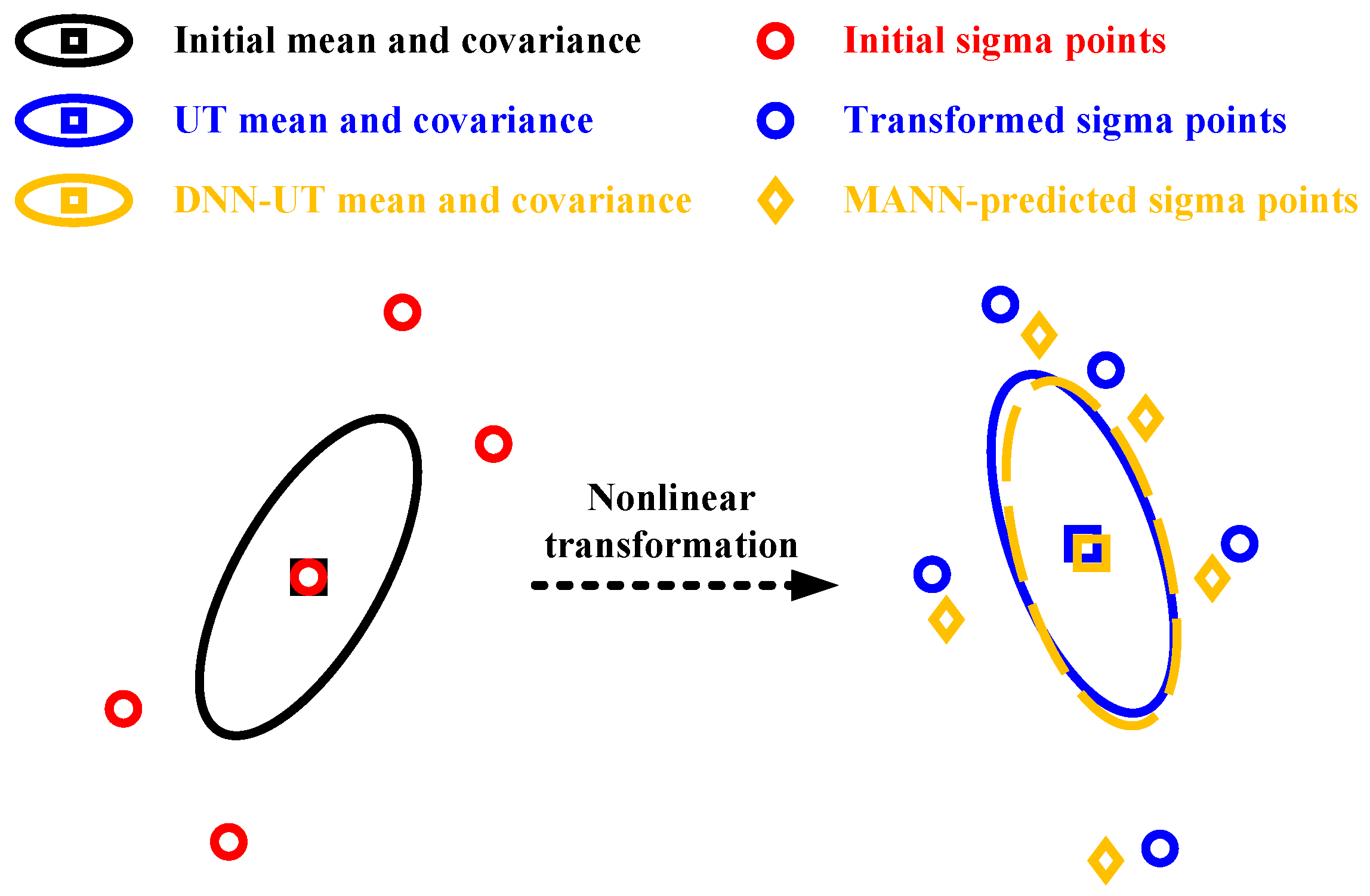
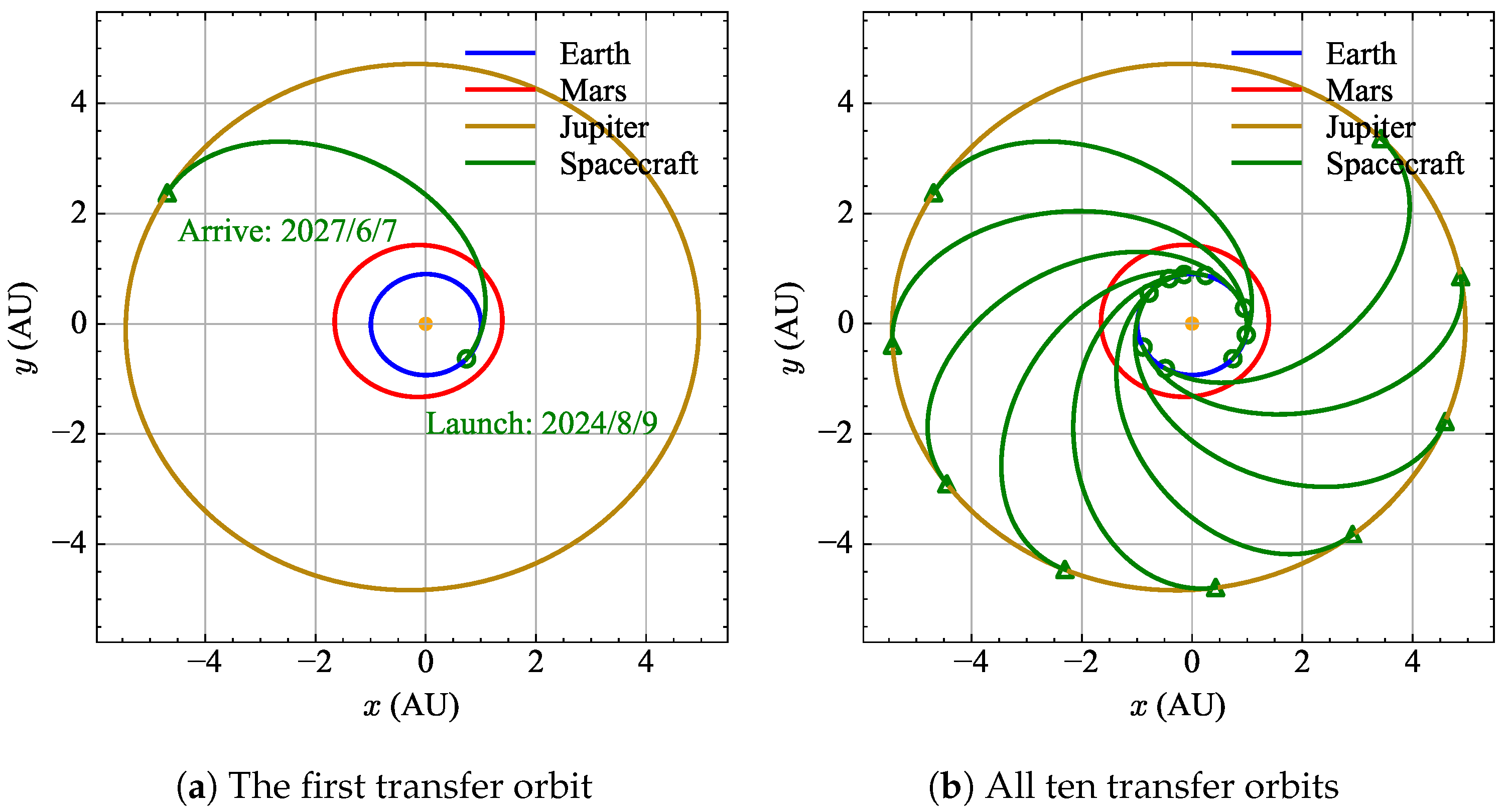
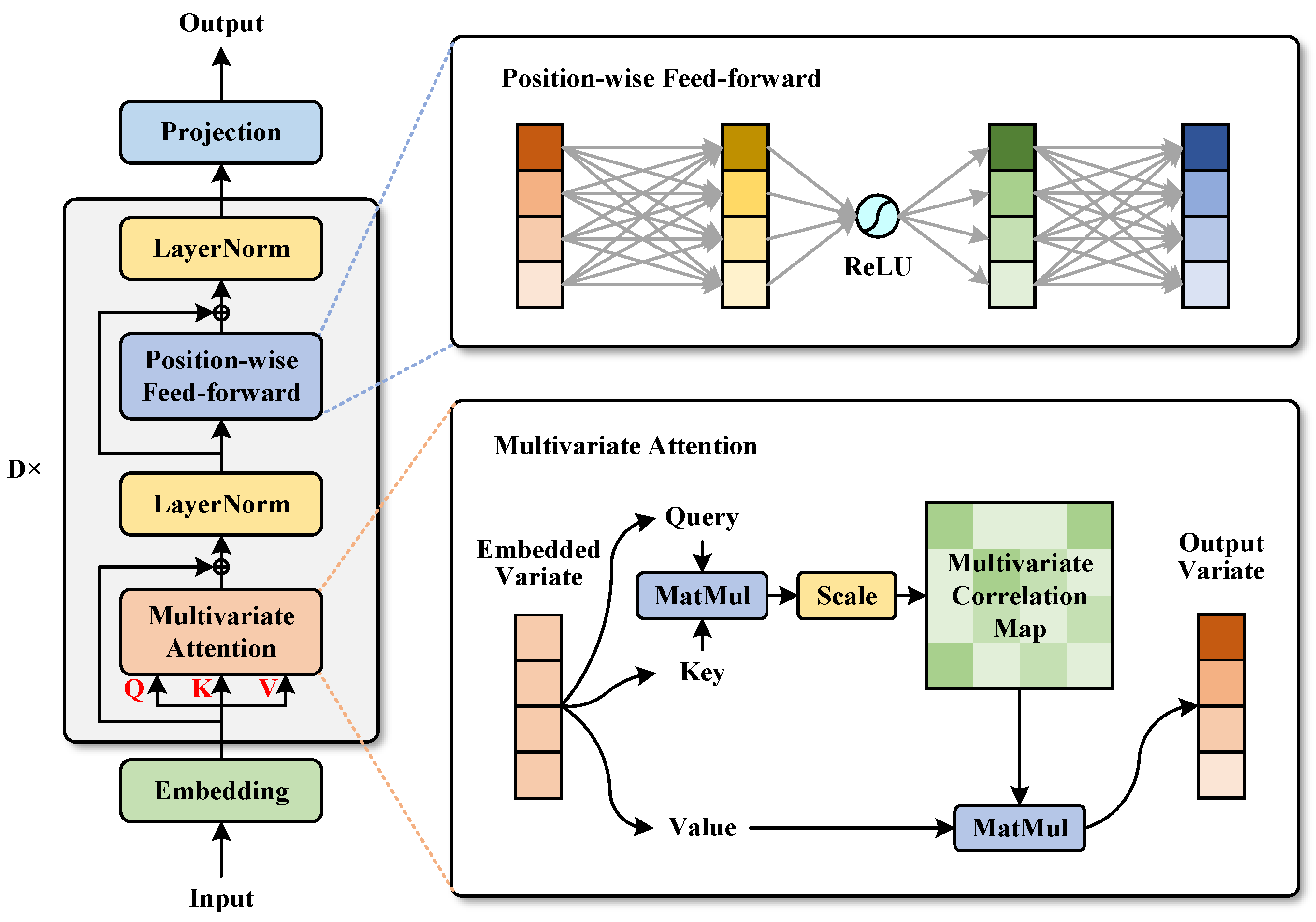
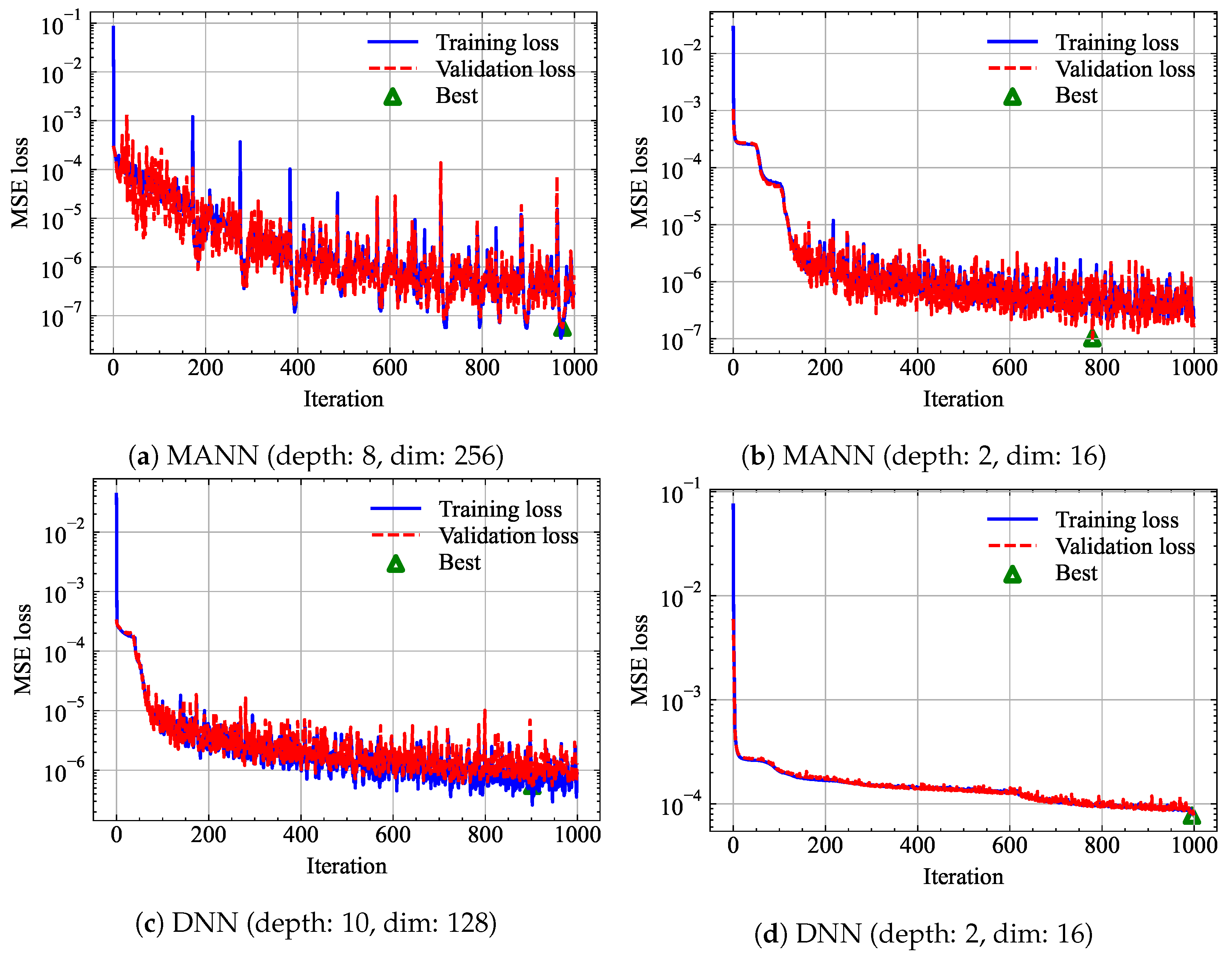
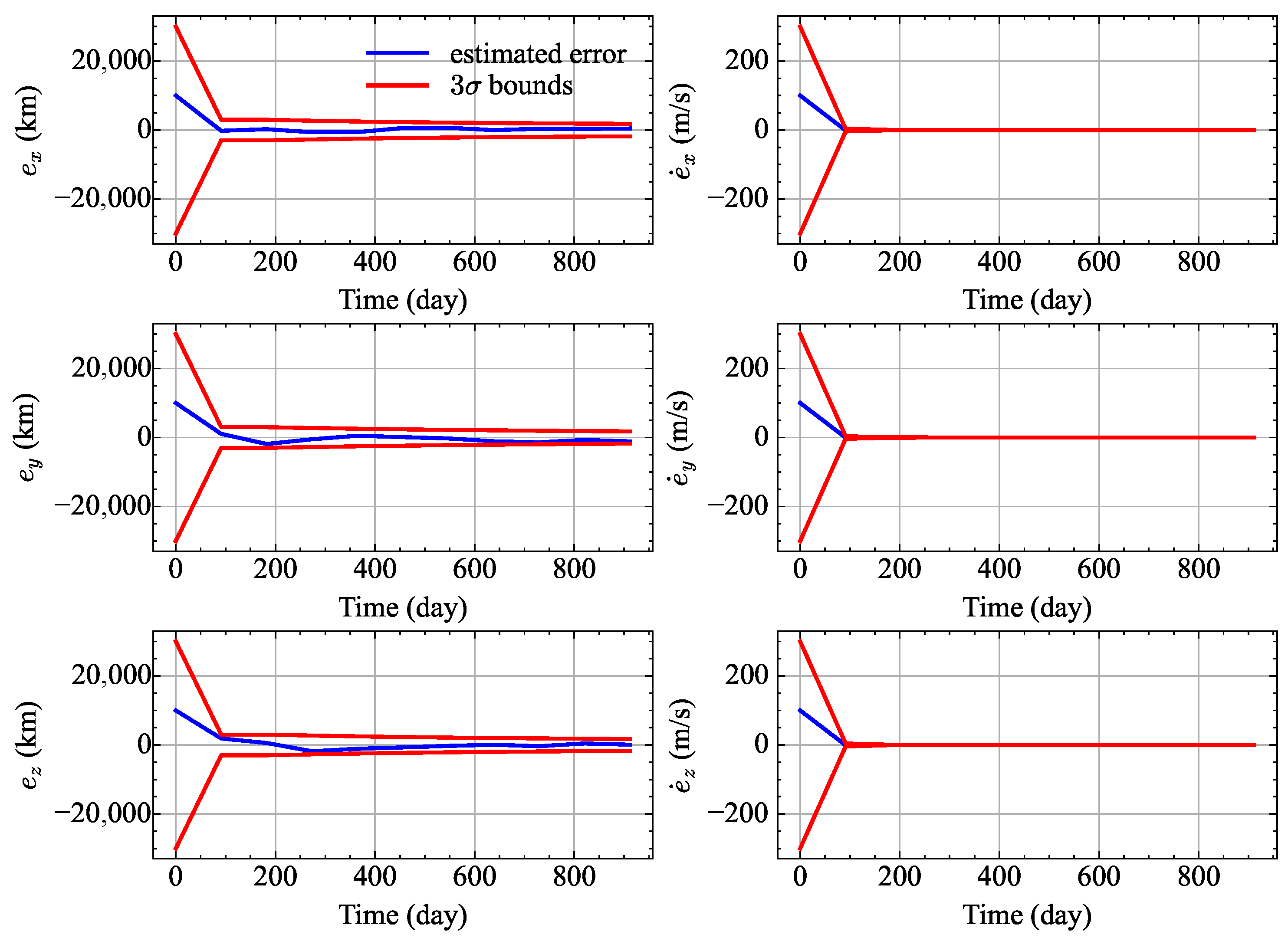
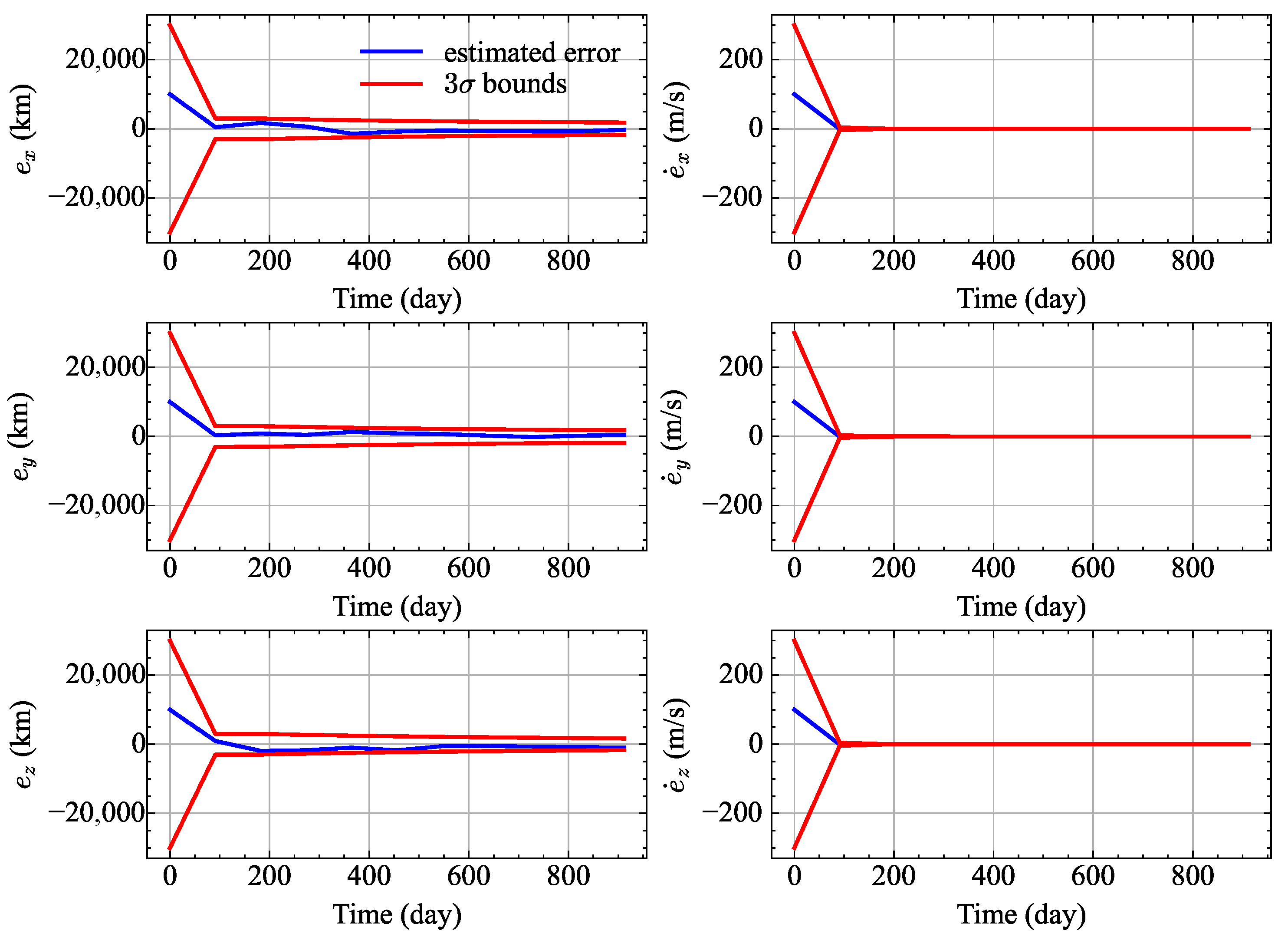

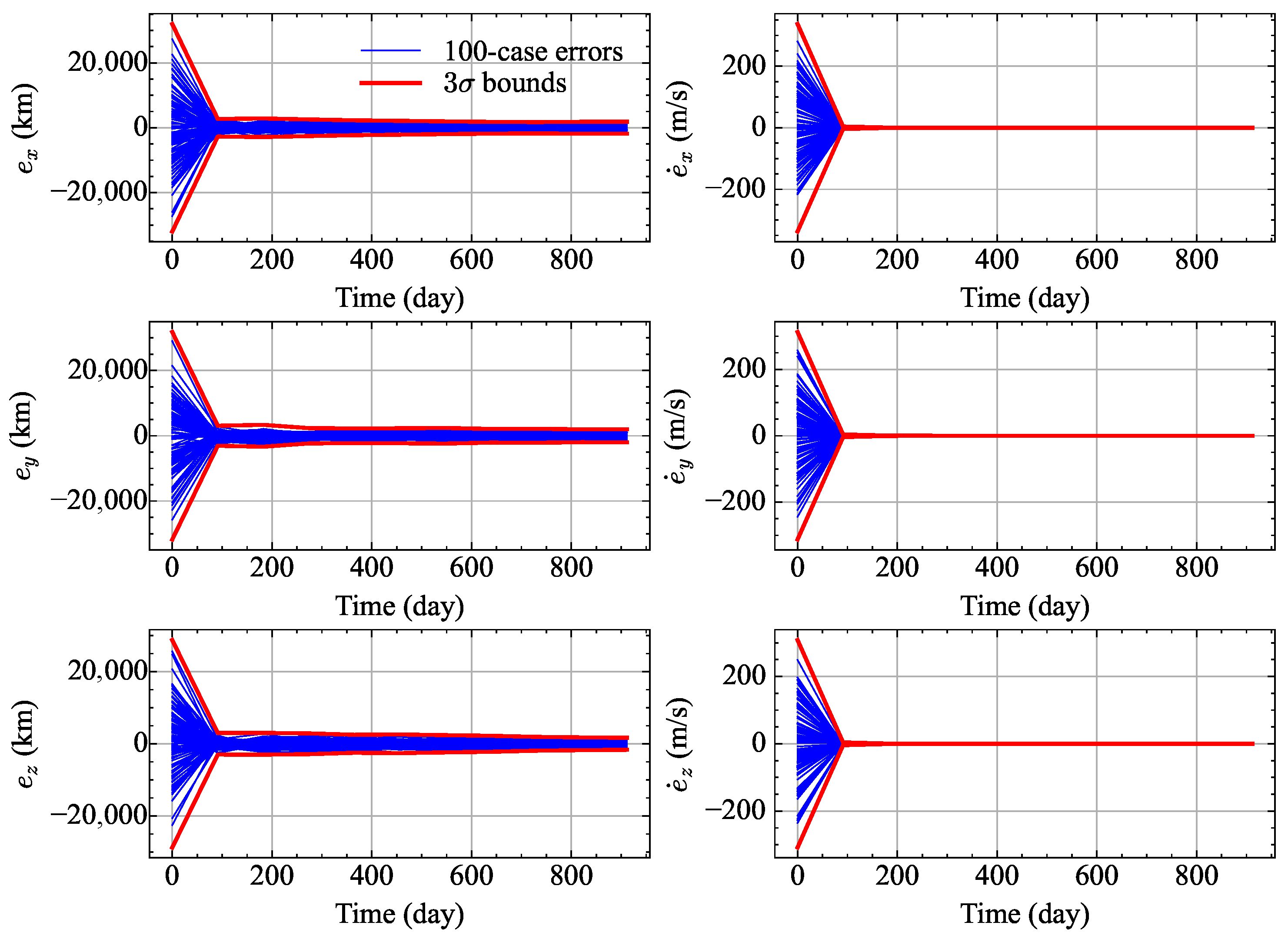
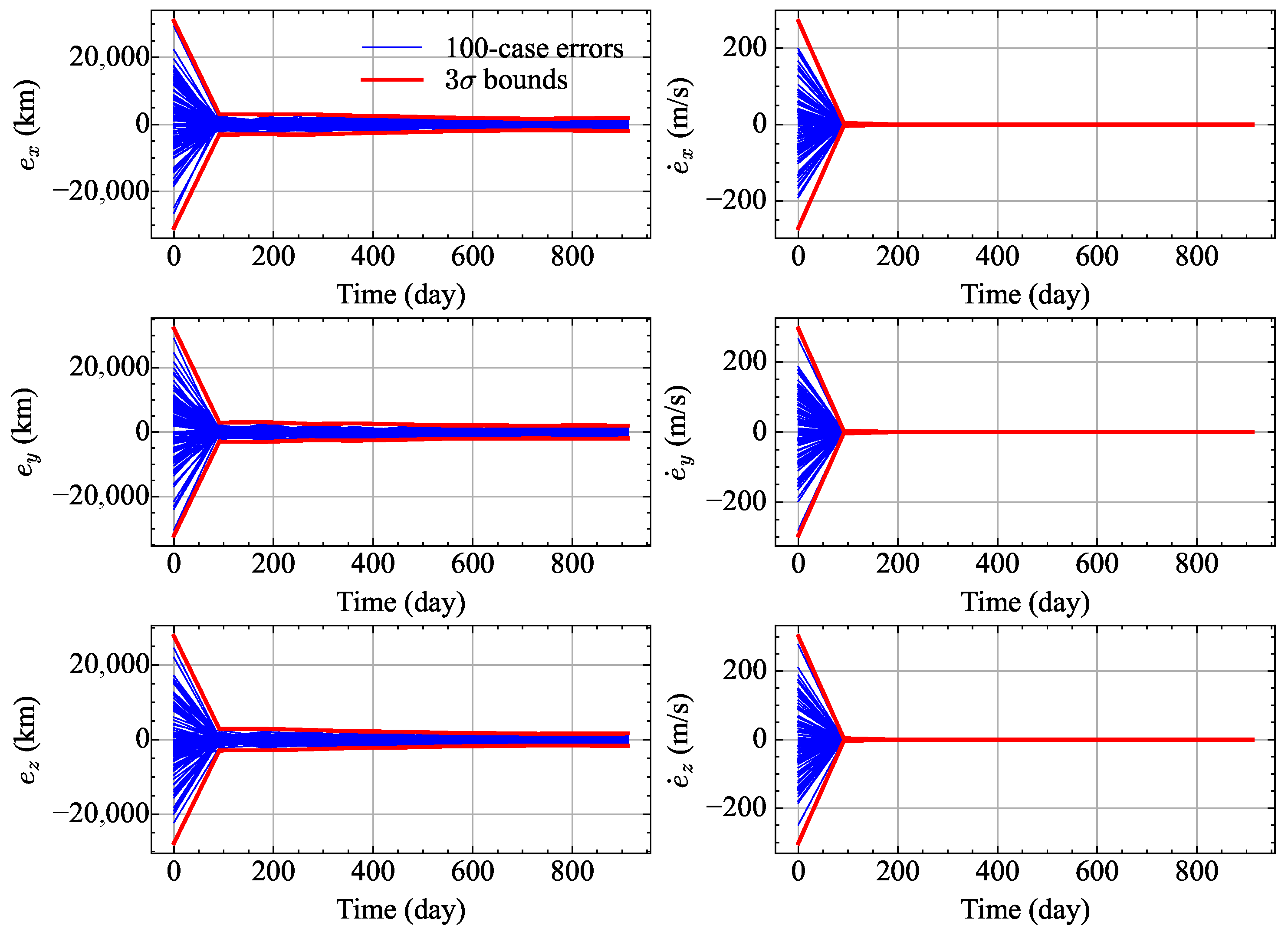
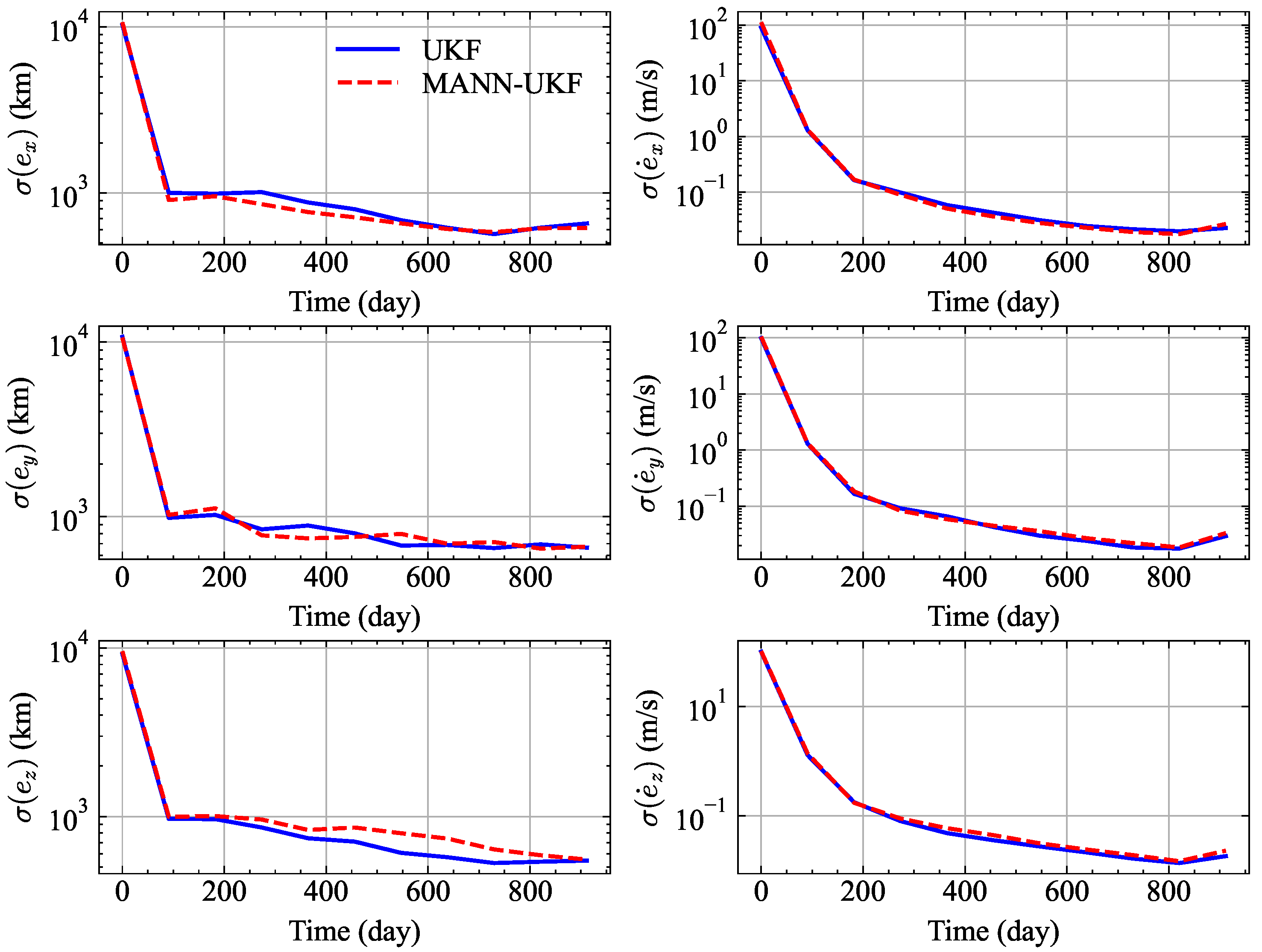
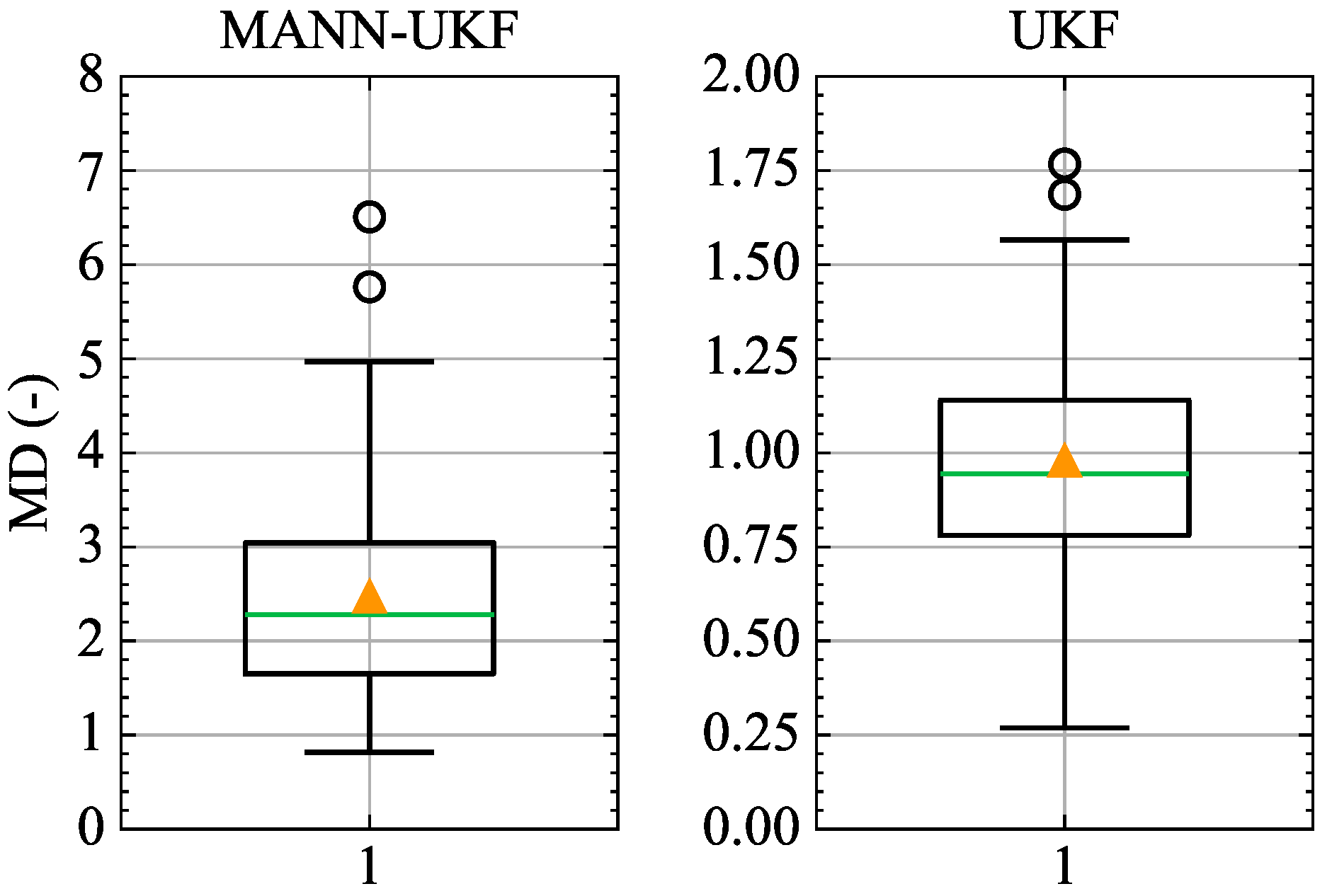

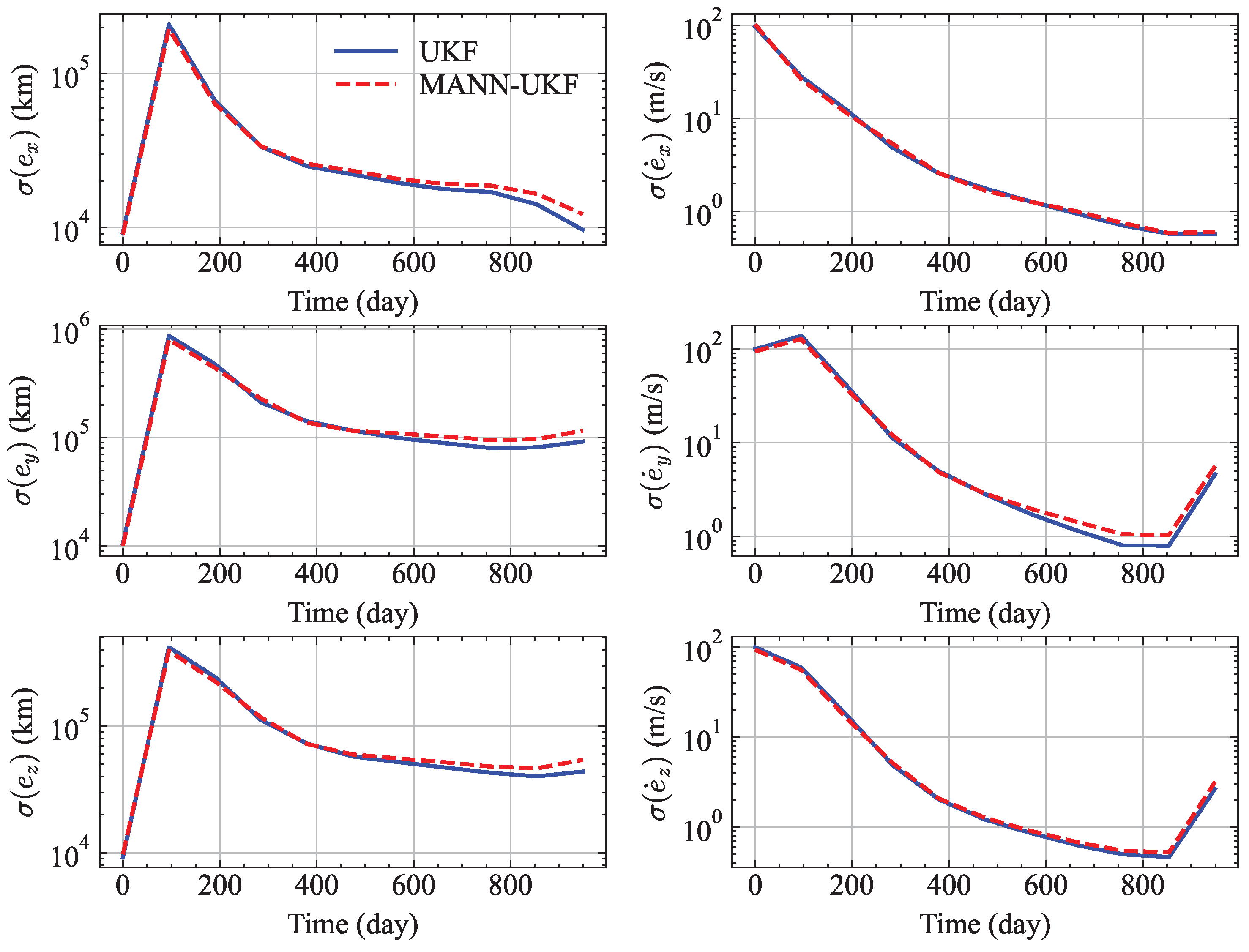
| Depth | Dim | Minimal Training MSE Loss | Minimal Validation MSE Loss |
|---|---|---|---|
| 2 | 16 | ||
| 32 | |||
| 64 | |||
| 128 | |||
| 256 | |||
| 4 | 16 | ||
| 32 | |||
| 64 | |||
| 128 | |||
| 256 | |||
| 6 | 16 | ||
| 32 | |||
| 64 | |||
| 128 | |||
| 256 | |||
| 8 | 16 | ||
| 32 | |||
| 64 | |||
| 128 | |||
| 256 |
| Depth | Dim | Minimal Training MSE Loss | Minimal Validation MSE Loss |
|---|---|---|---|
| 2 | 16 | ||
| 32 | |||
| 64 | |||
| 128 | |||
| 4 | 16 | ||
| 32 | |||
| 64 | |||
| 128 | |||
| 6 | 16 | ||
| 32 | |||
| 64 | |||
| 128 | |||
| 8 | 16 | ||
| 32 | |||
| 64 | |||
| 128 | |||
| 10 | 16 | ||
| 32 | |||
| 64 | |||
| 128 |
| Parameters | Values | |
|---|---|---|
| Initial position vector (km) | x | |
| y | ||
| z | ||
| Initial velocity vector (km/s) | x | |
| y | ||
| z | ||
| Initial epoch | 8 October 2024 10:02:47 | |
| Ending epoch | 8 April 2027 02:19:21 | |
| Mean (s) | Maximum (s) | Minimum (s) | |
|---|---|---|---|
| MANN-UKF | 0.5423 | 0.5925 | 0.5248 |
| UKF | 6.6188 | 6.7804 | 6.4218 |
| Parameters | Values | |
|---|---|---|
| Initial position vector (km) | x | |
| y | ||
| z | ||
| Initial velocity vector (km/s) | x | |
| y | ||
| z | ||
| Initial epoch | 9 November 2025 03:39:46 | |
| Ending epoch | 15 June 2028 06:27:40 | |
Disclaimer/Publisher’s Note: The statements, opinions and data contained in all publications are solely those of the individual author(s) and contributor(s) and not of MDPI and/or the editor(s). MDPI and/or the editor(s) disclaim responsibility for any injury to people or property resulting from any ideas, methods, instructions or products referred to in the content. |
© 2024 by the authors. Licensee MDPI, Basel, Switzerland. This article is an open access article distributed under the terms and conditions of the Creative Commons Attribution (CC BY) license (https://creativecommons.org/licenses/by/4.0/).
Share and Cite
Zhang, Z.; Shi, Y.; Han, H. Multivariate Attention-Based Orbit Uncertainty Propagation and Orbit Determination Method for Earth–Jupiter Transfer. Appl. Sci. 2024, 14, 4263. https://doi.org/10.3390/app14104263
Zhang Z, Shi Y, Han H. Multivariate Attention-Based Orbit Uncertainty Propagation and Orbit Determination Method for Earth–Jupiter Transfer. Applied Sciences. 2024; 14(10):4263. https://doi.org/10.3390/app14104263
Chicago/Turabian StyleZhang, Zhe, Yishuai Shi, and Hongwei Han. 2024. "Multivariate Attention-Based Orbit Uncertainty Propagation and Orbit Determination Method for Earth–Jupiter Transfer" Applied Sciences 14, no. 10: 4263. https://doi.org/10.3390/app14104263
APA StyleZhang, Z., Shi, Y., & Han, H. (2024). Multivariate Attention-Based Orbit Uncertainty Propagation and Orbit Determination Method for Earth–Jupiter Transfer. Applied Sciences, 14(10), 4263. https://doi.org/10.3390/app14104263






